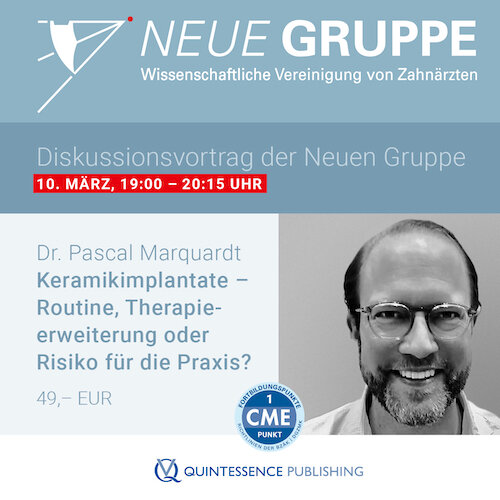Implantologie, 4/2018
Pages 383-392, Language: GermanMarquardt, Pascal / Krueger-Janson, LeaDank neuer Innovationen können Keramikimplantate immer häufiger eingesetzt werden. Besonders in der ästhetischen Zone und beim Weichgewebemanagement scheinen sie als Alternative zu Titanimplantaten infrage zu kommen. Die Metallfreiheit von Keramikimplantaten bietet zudem die Möglichkeit eines erweiterten Behandlungsspektrums. Der vorliegende Fallbericht beschreibt schrittweise die verzögerte Sofortimplantation und Versorgung mit einem zweiteiligen Keramikimplantat und diskutiert klinisch relevante Aspekte einer solchen Versorgung für die Praxis.
Keywords: Keramikimplantat, Zweiteiligkeit, Frontzahnimplantat, ästhetische Zone, verzögerte Sofortimplantation
QZ - Quintessenz Zahntechnik, 12/2010
SpecialPages 1630-1642, Language: GermanMarquardt, PascalDreidimensionale Röntgendaten des Kiefers wurden in der oralen Implantologie zunächst nur für die Umsetzung von digitalen Planungsdaten in Form der Führung der Pilotbohrung genutzt. Heute werden zur präzisen Übertragung der am Monitor geplanten Implantatposition speziell auf das Implantatsystem abgestimmte Bohrer-Hülsensystemen angeboten. Neben der konventionellen labortechnischen Herstellungsmethode stellen volldigital durch CAD/CAM-Technik oder innovative 3-D-Drucker hergestellte Schienen eine Alternative dar. Derart hergestellte Schienen sind in der Genauigkeit mit konventionellen Schienen vergleichbar, reduzieren jedoch die Komplexität des Behandlungsablaufs.
Keywords: Implantatprothetik, digitale Volumentomografie, DICOM, CAD/CAM, Implantatnavigation, SIC Guided Surgery, Systemdarstellung, Patientenfall
QZ - Quintessenz Zahntechnik, 10/2008
Case ReportPages 1224-1234, Language: GermanMarquardt, PascalIn der oralen Implantologie ist eine präzise präoperative Planung sowohl der Implantatinsertion als auch der prothetischen Versorgung wichtigste Grundlage einer erfolgreichen Rehabilitation des implantatprothetisch zu versorgenden Patienten. Die radiologischen Daten können durch moderne dreidimensionale Aufnahmetechniken wie der digitalen Volumentomographie mit niedriger Strahlenbelastung bei ausgezeichneter Bildgenauigkeit gewonnen und mit verschiedenen Softwareprogrammen bearbeitet werden. Ebenso kann heute die exakte dreidimensionale Position der geplanten Implantate im Vorfeld der Implantatinsertion bestimmt und in den Operationssitus übertragen werde. Eine so geplante Behandlung wird schnell, wenig invasiv und vor allem vorhersagbar durchgeführt.
Keywords: Implantatprothetik, digitalen Volumentomographie, schienengeführte 3D-Navigation, laborgefertigte Schienen, stereolithographisch gefertigte Schienen
International Journal of Esthetic Dentistry (DE), 1/2007
Pages 82-100, Language: GermanMarquardt, Pascal/Witkowski, Siegbert/Strub, JörgIn der oralen Implantologie ist heute eine präzise präoperative Planung sowohl der Implantatinsertion als auch der prothetischen Versorgung die wichtigste Grundlage einer erfolgreichen Rehabilitation des implantatprothetisch zu versorgenden Patienten. Die radiologischen Daten können durch moderne dreidimensionale Aufnahmetechniken wie der digitalen Volumentomografie mit sehr niedriger Strahlenbelastung bei ausgezeichneter Bildgenauigkeit gewonnen und mit verschiedenen Softwareprogrammen bearbeitet werden. Konnte bisher nur die Position der Implantatschulter oder die Achse der Bohrung in die klinische Anwendung umgesetzt werden, ist es heute möglich, die exakte dreidimensionale Position der geplanten Implantate im Vorfeld der Implantatinsertion zu bestimmen und in den Operationssitus zu übertragen. Vor Operationsbeginn kann eine prothetische Versorgung angefertigt und dem Patienten unmittelbar nach der Operation eingegliedert werden. Eine so geplante Behandlung wird schnell, wenig invasiv und vor allem vorhersagbar durchgeführt. Dies steigert die Qualität sowohl des chirurgischen Eingriffs als auch der prothetischen Versorgung. Zur dreidimensionalen Navigation können in der oralen Implantologie sowohl statische Systeme, die auf Führungsschienen basieren, wie auch optische, dynamische Navigationssysteme angewandt werden. Der folgende Artikel gibt einen Überblick über aktuelle Systeme zur geführten Implantation und deren Einsatzgebiete.
International Journal of Esthetic Dentistry (EN), 1/2007
PubMed ID (PMID): 19655496Pages 80-98, Language: EnglishMarquardt, Pascal / Witkowski, Siegbert / Strub, JörgIn implant dentistry today, precise preoperative planning of both the implant placement and the restoration is a critical prerequisite to succeeding in the oral rehabilitation of patients with dental implants. Modern three-dimensional imaging techniques such as digital volume tomography allow the acquisition of radiologic data with very low levels of radiation and excellent image accuracy, and also allow the processing of these data with various types of software applications. Formerly, only the position of the implant collar or the axis of the osteotomy could be transferred into the clinical setting; it is now possible to predetermine the precise three-dimensional position of the planned implant before the actual implant insertion, and to transfer this position to the surgical site. Thus, the restoration can be fabricated before surgery and can be placed into the patient's mouth immediately after surgery. Treatment planned in this way is fast, minimally invasive, and most importantly, predictable. This increases the quality of both the surgical procedure and the restoration. For three-dimensional navigation in implant dentistry there are static systems based on both surgical guides and optical, dynamic navigation systems. This article is an overview of the latest systems for guided implant insertion and their fields of application.
Quintessence International, 4/2006
PubMed ID (PMID): 16594356Pages 253-259, Language: EnglishMarquardt, Pascal/Strub, Jörg RudolfObjective: The aim of this prospective clinical study was to evaluate the survival rates of IPS Empress 2 (Ivoclar Vivadent) all-ceramic crowns and fixed partial dentures (FPDs) after an observation period of up to 5 years.
Method and Materials: Forty-three patients (19 women and 24 men) were included in this study. The patients were treated with a total of 58 adhesive bonded IPS Empress 2 restorations. A total of 27 single crowns were placed on molars and premolars, and 31 three-unit FPDs were placed in the anterior and premolar regions. Clinical follow-up examinations took place at 6, 12, 24, 36, 48, and 60 months after insertion. Statistical analysis of the data was calculated using the Kaplan-Meier method.
Results: Results of the 50-month analysis (interquartile range, 33 to 61 months) showed that the survival rate was 100% for crowns and 70% for FPDs. Six failures that occurred exclusively in the three-unit FPDs were observed. Framework fractures were recorded in three FPD units where the connector dimensions did not meet the manufacturer specifications. Only one FPD exhibited an irreparable partial veneer fracture, and 2 FPDs showed evidence of biologic failures. The accuracy of fit and esthetic parameters were clinically satisfactory for crowns and FPDs.
Conclusion: The results of this 5-year clinical evaluation suggest that IPS Empress 2 ceramic is an appropriate material for the fabrication of single crowns. Because of the reduced survival rates, strict conditions should be considered before the use of IPS Empress 2 material for the fabrication of three-unit FPDs.
Keywords: all-ceramic, crowns, fixed partial dentures, IPS Empress 2, survival rate
Implantologie, 3/2006
Pages 265-274, Language: GermanMarquardt, Pascal / Zech, PeterImplantatprothetische Versorgungen im interforaminalen Bereich des Unterkiefers sichern bei zahnlosen Patienten eine komfortable und effiziente Rehabilitation mit einer hervorragenden Langzeitprognose. Oft kann eine bedingt abnehmbare Brücke eingegliedert werden. Konventionell werden die Gerüste der Suprastrukturen im Goldgussverfahren hergestellt. Dieses Verfahren ist kostenintensiv und stellt an den Zahntechniker hohe Anforderungen. Mit modernen CAD/CAM-Systemen können heute präzise und spannungsfrei sitzende Gerüste aus Titan gefräst werden. Diese sind günstiger als Goldgussgerüste, sehr biokompatibel und besitzen ähnliche Materialeigenschaften wie hochgoldhaltige Legierungen. Im vorliegenden Fallbericht wird die Vorgehensweise dieser Behandlungsoption dargestellt.
Keywords: CNC, CAD/CAM, Implantatprothetik, zahnloser Kiefer, Titan






